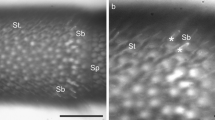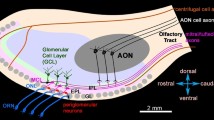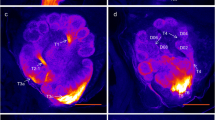Abstract
In honeybees (Apis mellifera), the biogenic amine octopamine has been shown to play a role in associative and non-associative learning and in the division of labour in the hive. Immunohistochemical studies indicate that the ventral unpaired median (VUM) neurones in the suboesophageal ganglion (SOG) are putatively octopaminergic and therefore might be involved in the octopaminergic modulation of behaviour. In contrast to our knowledge about the behavioural effects of octopamine, only one neurone (VUMmx1) has been related to a behavioural effect (the reward function during olfactory learning). In this study, we have investigated suboesophageal VUM neurones with fluorescent dye-tracing techniques and intracellular recordings combined with intracellular staining. Ten different VUM neurones have been found including six VUM neurones innervating neuropile regions of the brain and the SOG exclusively (central VUM neurones) and four VUM neurones with axons in peripheral nerves (peripheral VUM neurones). The central VUM neurones innervate the antennal lobes, the protocerebral lobes (including the lateral horn) and the mushroom body calyces. Of these, a novel mandibular VUM neurone, VUMmd1, exhibits the same branching pattern in the brain as VUMmx1 and responds to sucrose and odours in a similar way. The peripheral VUM neurones innervate the antennal and the mandibular nerves. In addition, we describe one labial unpaired median neurone with a dorsal cell body, DUMlb1. The possible homology between the honeybee VUM neurones and the unpaired median neurones in other insects is discussed.













Similar content being viewed by others
Abbreviations
- DUM neurone:
-
dorsal unpaired median neurone
- EPSPs:
-
excitatory post-synaptic potentials
- l-ACT:
-
lateral antenno-cerebralis tract
- LbMT:
-
labial midline tract
- mACT:
-
median antenno-cerebralis tract
- MdMT:
-
mandibular midline tract
- MT:
-
midline tract
- MxMT:
-
maxillary midline tract
- octopamine-IR:
-
octopamine-immunoreactive
- PL:
-
protocerebral lobe
- PTG:
-
prothoracic ganglion
- SOG:
-
suboesophageal ganglion
- US:
-
unconditioned stimulus
- VUM neurone:
-
ventral unpaired median neurone
References
Abel R, Rybak J, Menzel R (2001) Structure and response patterns of olfactory interneurones in the honeybee, Apis mellifera. J Comp Neurol 437:363–383
Allgäuer C, Honegger H (1993) The antennal motor system of crickets: modulation of muscle contractions by a common inhibitor, DUM neurones, and proctolin. J Comp Physiol [A] 173:485–494
Bicker G, Menzel R (1989) Chemical codes for the control of behaviour in arthropods. Nature 337:33–39
Bitterman M, Menzel R, Fietz A, Schäfer S (1983) Classical conditioning of proboscis extension in honeybees (Apis mellifera). J Comp Psychol 97:107–119
Bossing T, Technau G (1994) The fate of the CNS midline progenitors in Drosophila as revealed by a new method for single cell labelling. Development 120:1895–1906
Brandt R, Rohlfing T, Rybak J, Krofczik S, Maye A, Westerhoff M, Hege H-C, Menzel R (2006) A three-dimensional average-shape atlas of the honeybee brain and its applications. J Comp Neurol (in press)
Braun G, Bicker G (1992) Habituation of an appetitive reflex in the honeybee. J Neurophysiol 67:588–598
Bräunig P (1988) Identification of a single prothoracic “dorsal unpaired median” (DUM) neurone supplying locust mouthpart nerves. J Comp Physiol [A] 163:835–840
Bräunig P (1990) The morphology of suboesophageal ganglion cells innervating the nervus corporis cardiaci II of the locust. Cell Tissue Res 260:95–108
Bräunig P (1991) Suboesophageal DUM neurones innervate the principal neuropiles of the locust brain. Philos Trans R Soc Lond Biol 332:221–240
Bräunig P, Burrows M (2004) Projection patterns of posterior dorsal unpaired median neurones of the locust subesophageal ganglion. J Comp Neurol 478:164–175
Bräunig P, Eder M (1998) Locust dorsal unpaired medain (DUM) neurones directly innervate and modulate hindleg proprioreceptors. J Exp Biol 201:3333–3338
Bräunig P, Pflüger H-J (2001) The unpaired median neurones of insects. Adv Insect Physiol 28:185–266
Bräunig P, Allgäuer C, Honegger H (1990) Suboesophageal DUM neurones are part of the antennal motor system of locusts and crickets. Experientia 46:259–261
Breuer T (1994) Seitenspezifische Sensitisierung und klassische Konditionierung bei der Honigbiene, Apis mellifera. Diploma thesis, FU Berlin
Doe CQ, Goodman CS (1985) Early events in insect neurogenesis. I. Development and segmental differences in the pattern of neuroneal precursor cells. Dev Biol 111:193–205
Duch C, Mentel T, Pflüger H-J (1999) Distribution and activation of different types of octopaminergic DUM neurones in the locust. J Comp Neurol 403:119–134
Ehmer B, Gronenberg W (1997) Proprioreceptors and fast antennal reflexes in the ant Odontomachus (Formicidae, Ponerinae). Cell Tissue Res 290:153–165
Ellerkmann E (1994) Neuroneale Kontrolle und Modulation der Antennenbewegung bei der Honigbiene. PhD thesis, TU Berlin
Erber J, Pribbenow B, Kisch J, Faensen D (2000) Operant conditioning of antennal muscle activity in the honey bee (Apis mellifera L.). J Comp Physiol [A] 186:557–565
Farooqui T, Robinson K, Vaessin H, Smith B (2003) Modulation of early olfactory processing by an octopaminergic reinforcement pathway in the honeybee. J Neurosci 23:5370–5380
Frambach I, Rössler W, Winkler M, Schürmann F (2004) F-actin at identified synapses in the mushroom body neuropil of the insect brain. J Comp Neurol 475:303–314
Ganeshina O, Menzel R (2001) GABA-immunoreactive neurones in the mushroom bodies of the honeybee; an electron microscopic study. J Comp Neurol 437:335–349
Goodman L, Fletcher W, Guy R, Mobbs P, Pomfrett C (1987) Motion sensitive descending interneurones, ocellar LD neurones and neck motoneurones in the bee: a neural substrate for visual course control in Apis mellifera. In: Menzel R (ed) Neurobiology of the honeybee. Springer, Berlin Heidelberg New York, pp 158–171
Griss C, Rowell C (1986) Three descending interneurones reporting deviation from course in the locust. I. Anatomy. J Comp Physiol [A] 158:765–774
Hammer M (1987) Elektrophysiologische und anatomische Charakterisierung von Motoneuronen und Interneuronen im Unterschlundganglion der Honigbiene, Apis mellifera. Diploma thesis, FU Berlin
Hammer M (1991) Analyse der funktionellen Rolle des Neurones VUMmx1 bei der klassischen Konditionierung des Rüsselreflexes der Biene. PhD thesis, FU Berlin
Hammer M (1993) An identified neurone mediates the unconditioned stimulus in associative olfactory learning in honeybees. Nature 366:59–63
Hammer M (1997) The neural basis of associative reward learning in honeybees. Trends Neurosci 20:245–251
Hammer M, Menzel R (1995) Learning and memory in the honeybee. J Neurosci 15:1617–1630
Hammer M, Menzel R (1998) Multiple sites of associative odor learning as revealed by local brain microinjections of octopamine in honeybees. Learn Mem 5:146–156
Hammer M, Braun G, Mauelshagen J (1994) Food-induced arousal and nonassociative learning in honeybees: dependence of sensitization on the application site and duration of food stimulation. Behav Neural Biol 62:210–223
Homberg U (2002) Neurotransmitters and neuropeptides in the brain of the locust. Microsc Res Tech 56:189–209
Honegger H, Allgäuer C, Klepsch U, Welker J (1990) Morphology of antennal motoneurones in the brains of two crickets, Gryllus bimaculatus and Gryllus campestris. J Comp Neurol 291:256–268
Hoyle G (1978) The dorsal, unpaired, median neurones of the locust metathoracic ganglion. J Neurobiol 9:43–57
Ibbotson M (1991a) A motion-sensitive visual descending neurone in Apis mellifera monitoring translatory flowfields in the horizontal plane. J Exp Biol 157:573–577
Ibbotson M (1991b) Wide-field motion-sensitive neurones tuned to horizontal movement in the honeybee, Apis mellifera. J Comp Physiol [A] 168:91–102
Ibbotson M, Goodman L (1990) Response characteristics of four wide-field motion-sensitive descending interneurones in Apis mellifera. J Exp Biol 148:255–279
Jia X, Siegler M (2002) Midline lineages in grasshopper produce neuroneal siblings with asymmetric expression of engrailed. Development 129:5181–5193
Kanzaki R, Arbas E, Hildebrand J (1991) Physiology and morphology of descending neurones in pheromone-processing olfactory pathways in the male moth Manduca sexta. J Comp Physiol [A] 169:1–14
Kent K, Hildebrand J (1987) Cephalic sensory pathways in the central nervous system of larval Manduca sexta (Lepidoptera: Sphingidae). Philos Trans R Soc Lond Biol 315:1–36
Kloppenburg P (1995) Anatomy of the antennal motoneurones in the brain of the honeybee (Apis mellifera). J Comp Neurol 363:333–343
Kreissl S, Eichmüller S, Bicker G, Rapus J, Eckert M (1994) Octopamine-like immunoreactivity in the brain and suboesophageal ganglion of the honeybee. J Comp Neurol 348:583–595
Lafon-Cazal M, Bockaert J (1985) Pharmacological characterization of octopamine sensitive adenylate cyclase in the flight muscle of Locusta migratoria L. Eur J Pharmacol 119:53–59
Mentel T, Duch C, Stypa H, Wegener G, Müller U, Pflüger H-J (2003) Central modulatory neurones control fuel selection in flight muscle of migratory locust. J Neurosci 23:1109–1113
Menzel R, Bitterman ME (1983) Learning by honey bees in an unnatural situation. In: Huber F, Markl H (eds) Neuroethology and behavioral physiology: roots and growing points. Springer, Berlin Heidelberg New York, pp 206–215
Menzel R, Müller U (1996) Learning and memory in honeybees: from behavior to neural substrates. Annu Rev Neurosci 19:379–404
Menzel R, Heyne A, Gerber B, Fiala A (1999) Pharmacological dissociation between the reinforcing, sensitizing and response releasing functions of reward in honeybee classical conditioning. Behav Neurosci 113:744–754
Mobbs P (1982) The brain of the honeybee Apis mellifera. I. The connections and spatial organization of the mushroom bodies. Philos Trans R Soc Lond Biol 298:309–354
Monastirioti M, Gorczyca M, Rapus J, Eckert M, White K, Budnik V (1995) Octopamine immunoreactivity in the fruit fly Drosophila melanogaster. J Comp Neurol 356:275–287
Müller D, Abel R, Brandt R, Zöckler M, Menzel R (2002) Differential parallel processing of olfactory information in the honeybee, Apis mellifera L. J Comp Physiol [A] 188:359–370
Nambu J, Lewis J, Crews S (1993) The development and function of the Drosophila CNS midline cells. Comp Biochem Physiol [A 104:399–409
Nässel D, Högmo O, Hallberg E (1984) Antennal receptors in the blowfly Calliphora erythrocephala. I. The gigantic central projection of the pedicellar campaniform sensillum. J Morphol 180:159–169
Nishikawa M, Yokohari F, Ishibashi T (1995) Central projections of the antennal cold receptor neurones and hygroreceptor neurones of the cockroach Periplaneta americana. J Comp Neurol 361:165–176
Orchard I, Lange A (1985) Evidence for octopaminergic modulation of an insect visceral muscle. J Neurobiol 16:171–181
O’Shea M, Rowell C, Williams J (1974) The anatomy of a locust visual interneurone; the descending contralateral movement detector. J Exp Biol 60:1–12
Pankiw T, Page R (2003) Effect of pheromones, hormones, and handling on sucrose response thresholds of honey bees (Apis mellifera L.). J Comp Physiol [A] 189:675–684
Pareto A (1972) Die zentrale Verteilung der Fühlerafferenz bei Arbeiterinnen der Honigbiene, Apis mellifera. Z Zellforsch 131:109–140
Pflüger H-J, Watson A (1988) Structure and distribution of dorsal unpaired median (DUM) neurones in the abdominal nerve cord of male and female locusts. J Comp Neurol 268:329–345
Pribbenow B, Erber J (1996) Modulation of antennal scanning in the honeybee by sucrose stimuli, serotonin, and octopamine: behaviour and electrophysiology. Neurobiol Learn Mem 66:109–120
Rehder V (1987) Zur Struktur und Funktion des Unterschlundganglions der Honigbiene, Apis mellifera. PhD thesis, FU Berlin
Rehder V (1988) A neuroanatomical map of the suboesophageal and the prothoracic ganglion of the honeybee (Apis mellifera). Proc R Soc Lond (Biol) 235:179–202
Rehder V (1989) Sensory pathways and motoneurones of the proboscisreflex in the suboesophageal ganglion of the honey bee. J Comp Neurol 279:499–513
Rillich J, Stevenson P, Schildberger K (2001) The mandibular motor system of the cricket. Thieme, Stuttgart
Roeder T (1999) Octopamine in invertebrates. Prog Neurobiol 59:533–561
Rohlfing T, Brandt R, Maurer CR, Menzel R (2001) Bee brains, b-splines and computational democracy: generating an average shape atlas. In: Proceedings of the IEEE Workshop on Mathematical Methods in Biomedical Image Analysis, MMBIA 2001, Kauai, Hawaii
Rybak J, Jennett A, Brandt R, Malun D (2001) Cellular localization of octopamine-like immunoreactivity in the honeybee brain. Sixth International Congress of Neuroethology, July 29-August 3, University of Bonn, abstract no. 339
Sandoz J-C, Hammer M, Menzel R (2002) Side-specificity of olfactory learning in the honeybee: US input side. Learn Mem 9:337–348
Scheiner R, Plückhahn S, Öney B, Blenau W, Erber J (2002) Behavioural pharmacology of octopamine, tyramine and dopamine in honey bees. Behav Brain Res 136:545–553
Scheiner R, Kuritz-Kaiser A, Menzel R, Erber J (2005) Sensory responsiveness and the effects of equal subjective rewards on tactile learning and memory of honeybees. Learn Mem 12:626–635
Schmid A, Chiba A, Doe C (1999) Clonal analysis of Drosophila embryonic neuroblasts: neural cell types, axon projections and muscle targets. Development 126:4653–4689
Schröter U, Malun D (2000) Formation of antennal lobe and mushroom body neuropils during metamorphosis in the honeybee, Apis mellifera.J Comp Neurol 422:229–245
Schröter U, Menzel R (2003) A new ascending sensory tract to the calyces of the honeybee mushroom body, the subesophageal-calycal tract.J Comp Neurol 465:168–178
Schulz D, Robinson G (2001) Octopamine influences division of labor in honeybee colonies. J Comp Physiol [A] 187:53–61
Schulz D, Barron A, Robinson G (2002) A role for octopamine in honey bee division of labor. Brain Behav Evol 60:350–359
Smid H, Bleeker M, Loon J van, Vet L (2003) Three-dimensional organization of the glomeruli in the antennal lobe of the parasitoid wasps Cotesia glomerata and C. rubecula. Cell Tissue Res 312:237–248
Stern M, Thompson K, Zhou P, Watson D, Midgley J, Gewecke M, Bacon J (1995) Octopaminergic neurones in the locust brain: morphological, biochemical and electrophysiological characterization of potent modulators of the visual system. J Comp Physiol [A] 177:611–625
Stevenson P (1999) Colocalisation of taurine- with transmitter-immunoreactivities in the nervous system of the migratory locust. J Comp Neurol 404:86–96
Stevenson P, Meuser S (1997) Octopaminergic innervation and modulation of a locust flight steering muscle. J Exp Biol 200:633–642
Stevenson P, Spörhase-Eichmann U (1995) Localization of octopaminergic neurones in insects. Comp Biochem Physiol [A] 110:203–215
Stevenson P, Pflüger H-J, Eckert M, Rapus J (1992) Octopamine immunoreactive cell populations in the locust thoracic-abdominal nervous system. J Comp Neurol 315:382–397
Strausfeld N, Bacon J (1983) Multimodal convergence in the central nervous system of dipterous insects. Fortschr Zool 28:47–76
Suzuki H (1975) Antennal movements induced by odour and central projection of the antennal neurones in the honey-bee. J Insect Physiol 21:831–847
Thompson K, Siegler M (1991) Anatomy and physiology of spiking local and intersegmental interneurones in the median neuroblast lineage of the grasshopper. J Comp Neurol 305:659–675
Thompson K, Siegler M (1993) Development of segment specificity in identified lineages of the grasshopper CNS. J Neurosci 13:3309–3318
Watson A (1984) The dorsal unpaired median neurones of the locust metathoracic ganglion: neuroneal structure and diversity, and synapse distribution. J Neurocytol 13:303–327
Yasuyama K, Meinertzhagen I, Schürmann F (2003) Synaptic connections of cholinergic antennal lobe relay neurones innervating the lateral horn neuropile in the brain of Drosophila melanogaster. J Comp Neurol 466:299–315
Acknowledgements
We are grateful to Drs. Michael Ibbotson and Jürgen Rybak for helpful comments on the manuscript and to Dr. Jürgen Rybak for his contributions to the improvement of the figures. We also thank Malte Westerhoff for his cooperation regarding the development of important Amira tools for the three-dimensional reconstruction of single neurones, and Mary Wurm for her help with the English.
Author information
Authors and Affiliations
Corresponding author
Additional information
This work was supported by the DFG ME 365/24-2.
Rights and permissions
About this article
Cite this article
Schröter, U., Malun, D. & Menzel, R. Innervation pattern of suboesophageal ventral unpaired median neurones in the honeybee brain. Cell Tissue Res 327, 647–667 (2007). https://doi.org/10.1007/s00441-006-0197-1
Received:
Accepted:
Published:
Issue Date:
DOI: https://doi.org/10.1007/s00441-006-0197-1




